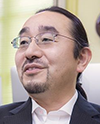Professor at the University of Tokyo, Hiroaki Suga devoted almost 20 years of research on the in vitro evolved artificial ribozyme system with exceptional outcomes. In this interview, he shares with us some salient aspects of his career and his vision of science and research.
Why are you active in the field of chemical biology?
There are many remaining scientific challenges in chemical biology and direct connections to drug discovery for unmet medical needs.
Describe the most intense moment of your career.
I would say it was a great experience to be exposed to a culturally and scientifically different country such as Switzerland, when I was studying and working in a laboratory at the University
of Lausanne back in 1987-88. This experience probably changed everything in my career.
Which is the best idea you ever had?
Having RNA catalysts, the flexizymes, for tRNA aminoacylation, which could catalyze reactions, that naturally occurring enzymes could not do well.
Do you have a role-model or a driving force?
All my mentors are my role-models. Particularly Professor Satoru Masamune and Jack W. Szostak are exceptional.
The philosophy along which lines you lead your lab?
We will devise technologies that people would not even think to imitate.
Pick a paper you praise for the elegance of its demonstration.
I choose “Isolation of new ribozymes from alarge pool of random sequences” of Bartel and Szostak, published in Science in 1993. This is the breakthrough of artificial ribozyme selection and the following papers are also very exciting.
Can you shed light on the relevance of inter-disciplinarity for scientific breakthroughs?
I believe that the interdisciplinary interest in science occurs naturally. If it is needed, merging two fields of techniques or research interests should occur at any time or opportunity.
Define research in just three words.
You’ll find challenges.
How do you match the words beauty and science?
When something that no one thought possible gets realized, then you might find beauty in science.
A piece of advice you’d like to give to the young generation of researchers?
It would be very ordinary words: “think differently and aggressively”.
A book, song, poem, music or paintingthat you spot out and get inspiration from?
I am a blues/jazz guitar player. I cannot spot one song, but any improvisation made by great guitarists always inspires me for not only playing the guitar but also conducting research.
 Hiroaki Suga is a Professor of the Department of Chemistry, Graduate School of Science in the University of Tokyo. His research interests are in the field of bioorganic chemistry, chemical biology and biotechnology related to RNA, translation, and peptides. He received his Bachelor of Engineering (1986) and Master of Engineering (1989) from Okayama University under the supervision of Prof. S. Torii and his PhD in Chemistry (1994) from MIT under the supervision of Prof. S. Masamune. After three years of post-doctoral research with Prof. J. W. Szostak (Nobel Prize in Physiology or Medicine 2009) in the Massachusetts General Hospital, he was appointed as a tenure-track Assistant Professor in the Department of Chemistry in New York State University at Buffalo in 1997, then promoted in 2002 to tenured Associate Professor. In 2003, he moved to the Research Center for Advanced Science and Technology in the University of Tokyo as an Associate Professor and soon after was promoted to Full Professor. In 2010, he changed his affiliation and moved to his current Institute.
Hiroaki Suga is a Professor of the Department of Chemistry, Graduate School of Science in the University of Tokyo. His research interests are in the field of bioorganic chemistry, chemical biology and biotechnology related to RNA, translation, and peptides. He received his Bachelor of Engineering (1986) and Master of Engineering (1989) from Okayama University under the supervision of Prof. S. Torii and his PhD in Chemistry (1994) from MIT under the supervision of Prof. S. Masamune. After three years of post-doctoral research with Prof. J. W. Szostak (Nobel Prize in Physiology or Medicine 2009) in the Massachusetts General Hospital, he was appointed as a tenure-track Assistant Professor in the Department of Chemistry in New York State University at Buffalo in 1997, then promoted in 2002 to tenured Associate Professor. In 2003, he moved to the Research Center for Advanced Science and Technology in the University of Tokyo as an Associate Professor and soon after was promoted to Full Professor. In 2010, he changed his affiliation and moved to his current Institute.

Leave a comment
The editors reserve the right not to publish comments or to abridge them.